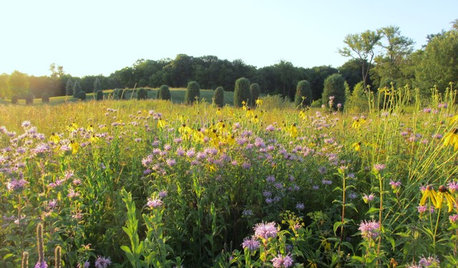I just received my April/May 2007 edition of the Journal of Forestry (Volume, and me 105, Number 3) and in this issue is an article titled "Pruning wounds and Occlusion: A Long Standing Conundrum in Forestry. This article forces me, and I hope all of you who have commented on this issue here in these forums, to reconsider or reject my/our previously held beliefs about the correct method of pruning branches from trees. This article is a review of research and observations on the subject going as far back as the 18 and 19th centuries and continuing up to the present.
The "conundrum" referred to in the title is defined by this paragraph from the article. I quote in full, but delete the footnotes referencing research studies):
"The conundrum over pruning techniques involves the branch collar or any additional living tissues at the base of the branch. Branch diameter decreases quite dramatically in a short distance from the stem, If the branch is cut flush with the stem (i.e. a flush or close cut), the resulting wound is larger than if the branch is cut outside the branch collar. If the branch is cut further from the stem )i.e. an outside the branch collar cut), the resulting wound at the end of the branch stub is smaller but the defect core will be larger because branch stubs are longer. The conundrum is whether a larger wound and a smaller defect core are preferable to a larger defect core and a smaller wound."
Let me explain that this concern with the "defect core" is a concern primarily of foresters trying to produce the most clear-grained wood from a tree after it is ready for harvest. But connected with this more direct concern related to commercial forestry are other issues of much concern to ornamental tree owners and urban foresters, and these are fully addressed in the article. This will be more clear as I proceed to try to summarize this article.
One of the key issues addressed in this article is the effect of cutting into the branch collar or leaving the branch collar intact and making a pruning cut following the "Natural Target Pruning" method advocated by Dr. Shigo (and, I might add ,advocated by me in a post I made several weeks ago in which I gave a fairly detailed description of how to make a pruning cut). One of the findings reported by this summary of research is that in general cutting into the branch collar to make a "close cut" (not necessarily a "flush" cut) instead of a cut outside the branch collar, stimulated callous growth so that the somewhat larger wound that the close cut made actually healed over faster than a cut outside the branch collar.
The article I am trying to summarize is fairly long and detailed, but to give you a taste of the research summarized within, I think I should quote some portions. Here is one of several paragraphs about the specific advantages of cutting into the branch collar. I quote the paragraph is full.
"Similar questions were asked and similar studies were undertaken in the 20th century. Adams and Sheller (1939) completed a detailed comparison of pruning through the branch collar and outside the branch collar in in eastern white pine. They looked at resin flow and callus formation on dead and live branch wounds 1 year after pruning. Resin flow is an initial defense to infection and during the growing season may occur within minutes of cutting. The chemical composition of resin changes after wounding to be more resistant to infection (Gref and Ericsson 1985), Cook and Hain 1987). Cutting branches through the branch collar increased both resin flow and callus formation. Additionally, resins are concentrated in the branch base: Koster (1943) reported resin concentrations in the branch bases in Norway spruce 10 times greater than those in the branch or bole. Adams and Sheller (1939) found over 97% of branches sawn through the branch base showed callus formation after 1 year compared with 18.9% of branches cut outside the branch collar. Paul (1938) concluded pruning cuts should be "well into the collar at the base of the branch" in eastern white pine and red pine, as did Barrett and Downs (1943) with eastern white pine in the southern Appalachians."
Other sections of this article deal with pruning various hardwood species, and report similar advantageous responses to cutting into the branch collar. But the literature on hardwoods is not so extensive as that on conifers.
I quote the following paragraph in full--I understand it may well be a harsh comment on the work of Dr. Shigo, which so many who have commented in these forums admire.
"The emphasis on the "natural target pruning" approach in current guidelines also establishes the persuasive power of books in our society. The common sources in pruning guidelines (e.g. Bedeker et al. [1995], and textbooks (Koslowski et al. 1991, 500; Nyland 2002, 470-471) for the outside branch collar approach are a series of books written and published by Shigo (1986, 1989, 1991). Not only were all three of these books self-published, they apparently underwent no peer review. Although these books are built, in part, on the authors substantial body of previous research--some of which was published in peer-reviewed literature--the thrust of this work is primarily observational descriptions of tree responses to injury; there is a general lack of quantitative data and no statistical comparisons of pruning methods.
In the conclusion to this article it is emphasized, if I can put it in my own colloquial terms, that there is more than one way to skin a cat (i.e. effective pruning can be done in a variety of ways) and not all cats are alike (i.e. not all trees show the same response to a given pruning method). But I can say that although this article reviews a large body of literature (there have been many scores of studies going back more than 200 years), The vast bulk of the evidence supports a method of pruning for most kinds of trees in most situations other than Dr. ShigoÂs "natural target pruning" that preserves the entire branch collar, and this article questions not only the quantity but also the quality of research upon which the "natural target pruning method (preserving the entire branch collar) is based.
This study certainly forces me to question my beliefs on the subject.
This Journal of Forestry is a publication of the Society of American Foresters and is generally not available on newsstands or in libraries. If any of you live near a university with a forestry program, you should be able to visit and read this publication. I have probably made this post far too long, but in view of the limited distribution this publication has to the general public, I thought some extensive quotations were in order.
--Spruce
















jennie
sprucemanOriginal Author
Related Discussions
Back to Eden Method experiment
Q
Help: Best methods for rose gardening during drought
Q
If you enjoy a challenge: Calling on the expert rosarians
Q
Organic disease control methods?
Q
Dibbit
sprucemanOriginal Author
sprucemanOriginal Author
alexander3_gw
pinetree30
bengz6westmd
sprucemanOriginal Author
pineresin
sprucemanOriginal Author
wisconsitom
alexander3_gw
pinetree30
sprucemanOriginal Author
rhizo_1 (North AL) zone 7
sprucemanOriginal Author
wisconsitom
lucy
sprucemanOriginal Author
sprucemanOriginal Author
pinetree30
wisconsitom
sprucemanOriginal Author
kevin_ohara
Pamchesbay
sprucemanOriginal Author
Pamchesbay
sprucemanOriginal Author
rdak
saccharum
sprucemanOriginal Author
sprucemanOriginal Author
rdak
saccharum
sprucemanOriginal Author
ronalawn82